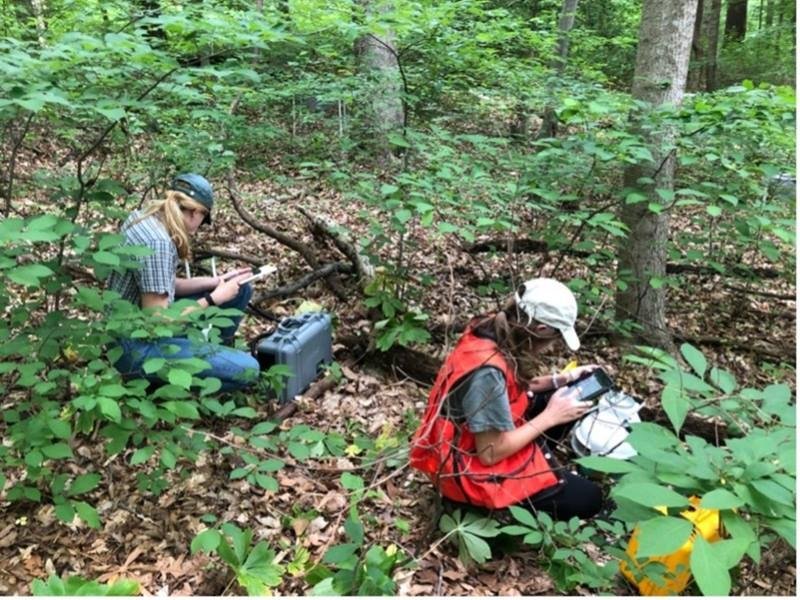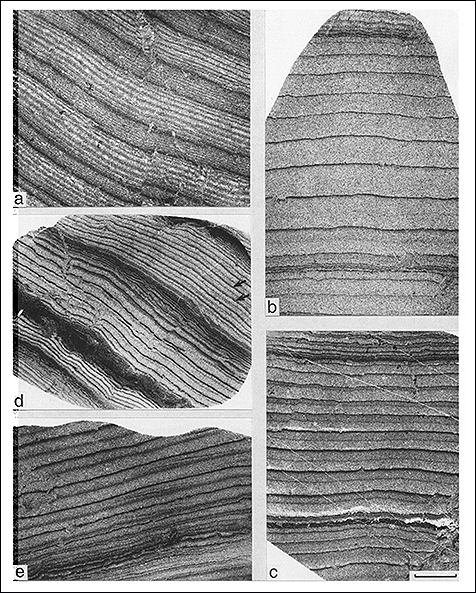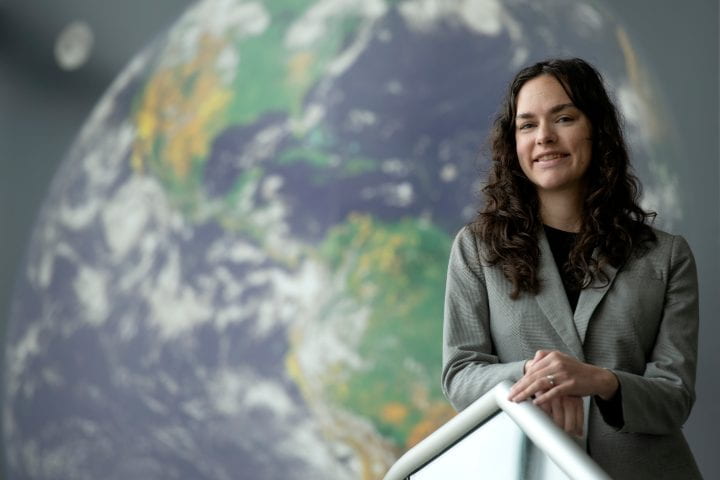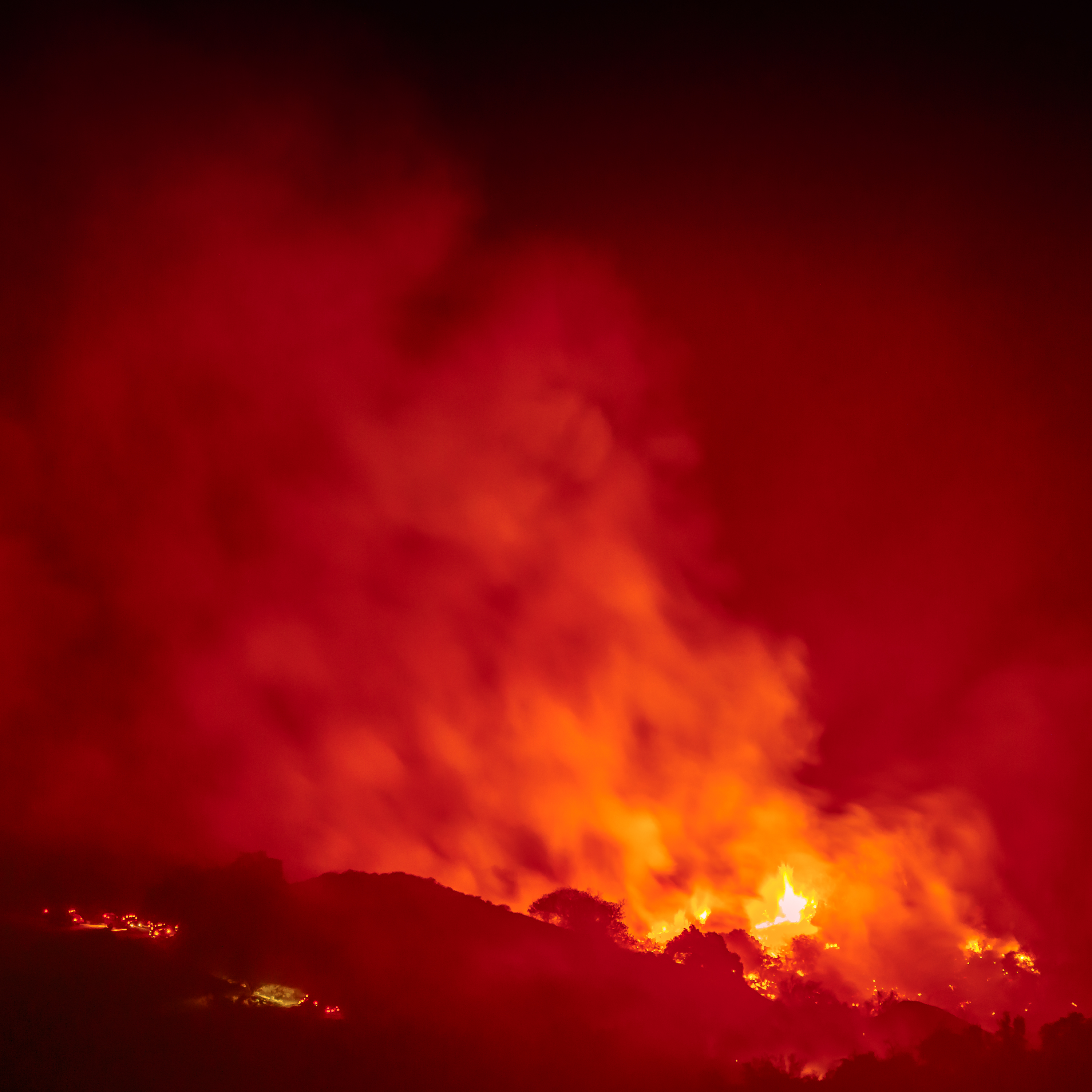Jakarta … San Francisco … Shanghai … Phoenix … Houston. These major cities and others around the globe have many similarities, but they share one particular commonality that is concerning for residents. They are among the global cities most affected by climate change.
Tag: Climate Change
UAH gains $617K funding for two Department of Energy atmospheric research grants aimed to improve climate models
The U.S. Department of Energy (DOE) has announced that researchers at The University of Alabama in Huntsville (UAH) have been awarded two projects designed to investigate the characteristics and evolution of convective clouds through advanced modeling. The projects are aimed at improving the capabilities of Earth system models to predict weather and climate changes.
Climate scientist finds new way to measure the Earth’s ability to offset carbon emissions
A Chapman University scientist and his colleagues have determined how the Earth responds as it heats up due to climate change.
Calling for Cancer Centers to Lead on Climate Disaster Preparedness
Cancer centers are uniquely positioned to protect cancer patients from climate-driven disasters, but researchers identified significant shortcomings in emergency preparedness when it came to climate-related disasters.
Turning the Tide on Climate Change
From the thousands of feet of frozen glaciers to the rising seas off Savannah’s coast, Georgia Institute of Technology researchers are measuring, modeling, and predicting just how climate change is impacting our oceans.
Study finds European breeding birds respond only slowly to recent climate change
Over the last 30 years European breeding birds have shifted their range by, on average, 2.4km per year, according to new research.
El Niño and record warm ocean temperatures: FSU climatologist offers insight on what they mean for hurricanes
By: Patty Cox | Published: July 20, 2023 | 12:52 pm | SHARE: Record-breaking high temperatures in the Atlantic Ocean combined with El Niño spell uncertainty for the Atlantic hurricane season. El Niño, known to reduce hurricane activity in the Atlantic basin, developed early this summer. With the conflicting factors of El Nino in the Pacific leading to fewer hurricanes and warm Atlantic Ocean temperatures favoring hurricane development, seasonal forecasts are for near-normal activity with lower confidence than other years.
Introducing the Climate Solutions Explorer
IIASA recently launched the Climate Solutions Explorer – a comprehensive resource that visualizes and presents vital data about climate mitigation, climate impacts, vulnerabilities, and risks arising from development and climate change.

Cities need plans for extreme heat, says expert, as heat waves stretch across the globe
Extreme heat is now plaguing parts of the U.S., Europe, and Asia. A Virginia Tech expert explains what is making this one of the hottest summers on record.
Brazilian coast is warmer and is having more frequent extreme temperature events, study shows
The Brazilian coast, especially in the South and Southeast regions, is already suffering from the impact of climate change, with increasingly extreme surface air temperatures and more frequent swings from heat to cold and back.
Study highlights urgent need to protect world’s forests from non-native pests in the face of climate change
CABI joined an international team of researchers from 57 institutions around the world to share its expertise in a ground-breaking study which highlights the urgent need to protect the world’s forests from non-native pests amid climate change.

The Legacy of Past Disturbance Shapes Coastal Forest Soil Stability
Coastal forests are increasingly exposed to the effects of climate change and sea level rise. New experimental research examined how soils change when transplanted between parts of a tidal creek that differed in salinity. Scientists found that soils with a history of salinity and inundation by seawater were more resistant to changes in water conditions, suggesting that soils learn from their history of inundation.
AgriLife Research computer modeling researchers recognized
Two computer modeling and big data researchers at the Texas A&M AgriLife Blackland Research and Extension Center at Temple were part of a team award from a U.S. Department of Agriculture undersecretary recognizing contributions to farm production and conservation.
Addressing adaptation inequalities in climate research
A new study proposes ways to better incorporate adaptation in climate change research, addressing the uneven distribution of adaptation capacities and needs worldwide.
Changing Seasons: Jet Shift Causes Seasonally Dependent Future Changes in the Midwest Hydroclimate
A new study that aims to resolve uncertainty in projections of future changes in the U.S. Midwest rainy season projects that while future seasonal mean precipitation will not change significantly, late spring precipitation will increase and late summer rainfall will decrease. The study indicates these changes will be driven by the poleward shift in the North American westerly jet due to climate change. The results may mean an increased risk of late-spring deluges and late-summer droughts for the Midwest.
Small-winged and lighter colored butterflies likely to be at greatest threat from climate change
Butterflies with smaller or lighter coloured wings are likely to be ‘losers’ when it comes to climate change, with the Lycaenidae family, which contains over 6,000 species of butterflies, the majority of which live in the tropics, found to be particularly vulnerable.
Higher Temperatures, Higher Risk for Algal Blooms, Higher Human Vulnerability
In a study published in the Environmental Health Perspective, a research team made up of scientists from across the country have found that environmentally relevant exposure to toxins found in algal blooms posed a risk to women’s reproductive health by heightening the probability…
Adding Snow to Estimates of Spring Flooding
By adding rain, snow, and rain-on-snow precipitation data to a background model, a new scheme pinpoints local flood risks in order to improve the design of small-scale hydrological infrastructure.
The ground is deforming, and buildings aren’t ready
There is a “silent hazard” lurking underneath our major global cities, and our buildings were not designed to handle it.
UMiami experts available to discuss impacts of extreme heat
CLIMATE SCIENCE Climate, weather, heat, rainfall, drought, flooding, anthropogenic warming — Amy Clement, professor of atmospheric sciences at the University of Miami’s Rosenstiel School of Marine, Atmospheric, and Earth Science. She is available to discuss the physical aspects of climate, Atlantic climate…
ARM Data Center: A World’s Worth of Atmospheric Data
The ARM Data Center collects and manages global observational and experimental data amassed by the Department of Energy (DOE) Office of Science’s Atmospheric Radiation Measurement user facility. The ARM Data Center gathers and curates some 50 terabytes of data per month from more than 460 instruments located in climate-critical locations worldwide. The data center processes and packages the information from these instruments into over 11,000 distinct data products. For the past 30 years, ARM has been making this data accessible to scientists around the world.
Synthesizing 200 Years of Research on the Urban Impact on Regional Climate and Extreme Weather
Urbanization has noticeable effects on processes at and near the Earth’s surface, affecting weather and climate. An international team of scientists reviewed more than 500 sources from the scientific literature produced over nearly 200 years on effects of urbanization on extreme weather and regional climate to better synthesize this knowledge and direct future research.
Prioritizing Equity and Inclusion in Carbon Removal Policy
Carbon Removal Justice Fellows Program at American University is a first-of-its-kind initiative to educate early career professionals and scientists in the social dimensions of policy for carbon removal
U.S. Secretary of Agriculture to join MSU’s Universal Food Forum in Washington D.C.
The College of Agriculture and Natural Resources at Michigan State University will host United States Secretary of Agriculture Tom Vilsack at the Universal Food Forum on Wednesday, July 12, 2023, at the Ronald Reagan Building and International Trade Center in Washington, D.C.
Climate change drives runoff from Arctic permafrost
Rising temperatures and changes in precipitation are driving increases to streamflow in areas of high-latitude North America where permafrost dominates the landscape.
Arctic dust found to be a major source of particles that form ice crystals in Arctic low-level clouds
Researchers have found that dust from land without snow cover in the Arctic is a major source of particles that form ice crystals in low-level clouds of the Arctic (at altitudes below about 3 km) during summer and fall.
Genetic changes have decreased maize’s tolerance to severe heat stress and increased resilience to moderate heat stress
The ability of crops to withstand heat is critical to our food system’s resilience to climate change.
New Insight into How Plant Cells Divide
Plant and animal stem cells both rely on the cytoskeleton to divide properly, but a new study finds that they use them in opposite ways—while animal cells pull on the cytoskeleton, plant cells push it away. Harnessing that action could help scientists engineer more resilient plants.
Top corn producing state to see future drop in yield, cover crop efficiency
How will future climate change affect nitrogen loss, and will cover crops still be effective in removing nitrogen from drainage water? A new study investigating near- and far-term climate change in Illinois suggests cover crops will still be beneficial, but not to the same degree. The report also forecasts major declines in corn production across the state in the future.
New IIASA online tool to visualize global migration patterns
IIASA researchers have developed a new tool – the Global Migration Data Explorer – to help address the lack of data on global migration flows and provide a visual method for exploring migration patterns worldwide.

Why the day is 24 hours long: Astrophysicists reveal why Earth’s day was a constant 19.5 hours for over a billion years
A team of astrophysicists at the University of Toronto (U of T) has revealed how the slow and steady lengthening of Earth’s day caused by the tidal pull of the moon was halted for over a billion years.
Potent greenhouse gas produced by industry could be readily abated with existing technologies
Researchers have found that one method of reducing greenhouse gas emissions is available, affordable, and capable of being implemented right now.
UTEP, PNNL Partner to Decarbonize Material Manufacturing
The Laboratory Directed Research and Development project is aimed at increasing knowledge about greener reduction processes to help accelerate and achieve CO2-free production of metals.
4000 scenarios for a climate turnaround
CO2 emissions from human activities account for about 42 billion tonnes per year. The Intergovernmental Panel on Climate Change (IPCC) has calculated that only another 300 to 600 billion tonnes can be added, from 2020 onwards, or else the goal of limiting global warming to 1.5 degrees Celsius will be virtually unattainable.
Climate crisis will fuel more intense ‘heat domes’
The brutal “heat dome” spreading beyond Texas is one of the worst the nation has seen. The weather phenomenon, which occurs when a persistent region of high-pressure traps heat over an area, will only become more frequent and intense with climate change, warns an atmospheric scientist.
Canadian wildfires and air quality: MSU experts can comment on public health, climate change impacts, pets and wildlife
Contact: Emilie Lorditch, University Communications, [email protected]; Nardy Baeza Bickel, MSU Health Sciences: [email protected]; EAST LANSING, Mich. – Wildfires in Canada are creating hazy skies and prompting air quality concerns from the Midwest to the East Coast of the United States. Michigan…
Mountains Vulnerable to Extreme Rain from Climate Change
A new study by Lab scientists finds that as rising global temperatures shift snow to rain, mountains across the Northern Hemisphere will be hotspots for extreme rainfall events that could trigger floods and landslides – potentially impacting a quarter of the world’s population.
There May Be Good News About the Oceans in a Globally Warmed World
An analysis of oxygen levels in Earth’s oceans may provide some rare, good news about the health of the seas in a future, globally warmed world.

UC Irvine scientists develop freely available risk model for hurricanes, tropical cyclones
As human-driven climate change amplifies natural disasters, hurricanes and typhoons stand to increase in intensity. Until now, there existed very few freely available computer models designed to estimate the economic costs of such events, but a team of researchers led by Jane W. Baldwin at the University of California, Irvine recently announced the completion of an open-source model that stands to help countries with high tropical cyclone risks better calculate just how much those storms will impact their people and their economies.
Flooding tackled by helping citizens take action – study
Extreme weather caused by climate change – such as flooding – will be to easier to prepare for after scientists developed a new method that empowers citizens to identify solutions to the threats their communities face.
Killer algae creeping down the coast of California
Algal blooms, exacerbated by climate change, shown to have a connection with several adverse health effects in humans and animals In the past month, thousands of sick or dead animals have been reported along the California coastline because of exposure…
Climate change could lead to “widespread chaos” for insect communities
New research from Binghamton University, State University of New York explores how a warming world could impact ecosystems and derail the development of new species.
A holistic approach to addressing food security in Africa
New research by an international team of researchers sheds light on the challenges and opportunities facing the African continent in securing sufficient food supplies with a particular focus on rice.
Assessment of How Climate Scientists Communicate Risk Shows Imperfections, Improvements
Scientists have long struggled to find the best way to present crucial facts about future sea level rise, but are getting better at communicating more clearly, according to an international group of climate scientists, including a leading Rutgers expert.

How will a warming world impact the Earth’s ability to offset our carbon emissions?
As the world heats up due to climate change, how much can we continue to depend on plants and soils to help alleviate some of our self-inflicted damage by removing carbon pollution from the atmosphere?
10-year countdown to sea-ice-free Arctic
If the world keeps increasing greenhouse gas emissions at its current speed, all sea ice in the Arctic will disappear in the 2030s, an event that could at best be postponed until the 2050s should emissions be somehow reduced.
Human-caused climate change to blame for increase in California’s wildfires
In the quarter century between 1996 and 2020, wildfires in California consumed five times more area than they did from 1971 to 1995. Researchers at the University of California and other international institutions have concluded that nearly all of the increase in scorched terrain can be blamed on human-caused climate change.

Human-caused climate change at the center of recent California wildfires
A new study by a Lawrence Livermore National Laboratory (LLNL) scientist and collaborators shows that nearly all the recent increase in summer wildfire burned area in California is attributable to human-caused (anthropogenic) climate change. Anthropogenic simulations yielded burn areas an average of 172% higher than natural variation simulations.
An AI tool that could help prevent wildfires
Wildfires are becoming more common, but machine learning can help cut them short
GW Experts Available: Smoke From Canadian Wildfires Remains Hazardous, Expands Reach
WASHINGTON (June 8, 2023)–The U.S. east coast continues to face hazardous and unhealthy air quality levels from Canada’s wildfires with many cities including New York, Philadelphia and Washington, D.C. experiencing the worst air quality in years. The National Oceanic and…